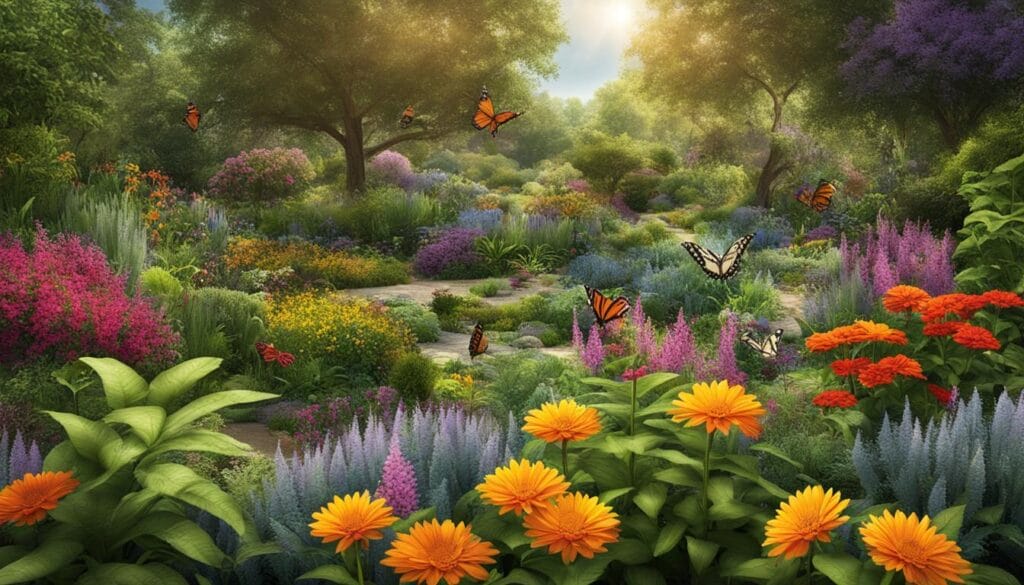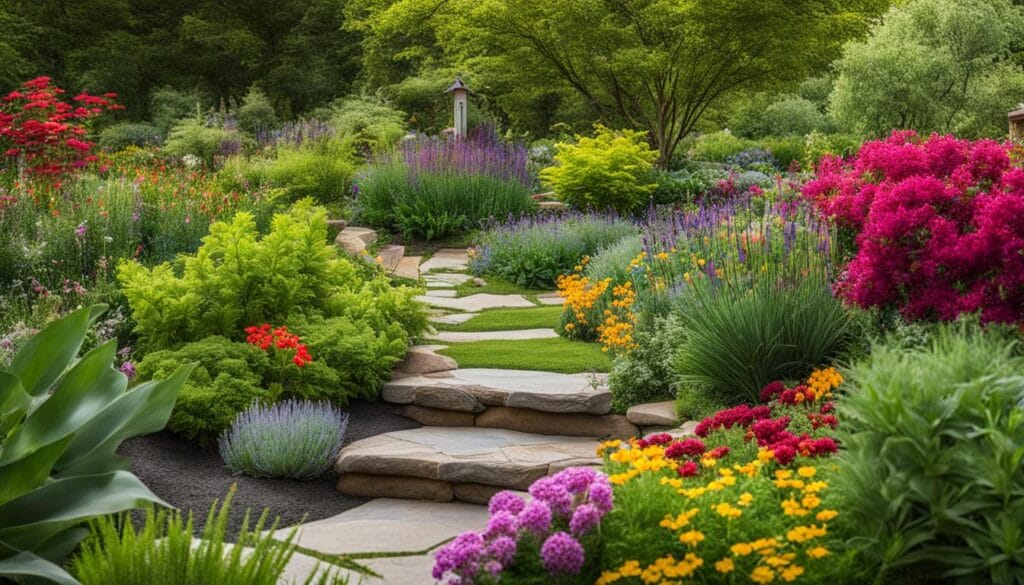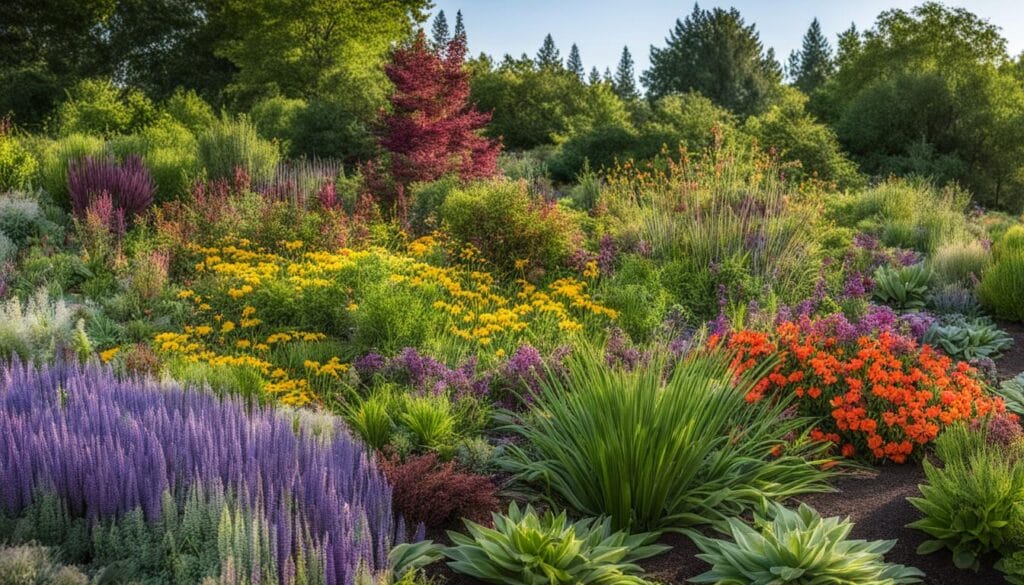Welcome to a world of biodiversity! In this article, we’ll explore the wonders of creating a biodiverse ecosystem with native plants. By embracing nature and implementing biodiversity techniques, you can transform your outdoor space into a thriving habitat that supports a wide array of wildlife. From Greening Australia’s initiatives to sustainable landscaping practices, we’ll guide you through the steps to create your own vibrant and sustainable garden. So, get ready to delve into the fascinating world of native planting strategies and discover the benefits of nurturing a biodiverse ecosystem.
Key Takeaways:
- Native plants promote biodiversity and provide essential food and habitat for local wildlife.
- Choosing native species over exotic plants is a sustainable choice for landscaping, requiring less water and chemical inputs.
- Implementing sustainable landscaping practices, such as rainwater harvesting and composting, conserves water and improves soil health.
- Researching and selecting native plants suited to your region’s soil type and sun exposure ensures successful planting.
- Incorporating wildlife habitats, such as birdhouses and bee-friendly gardens, supports ecological balance and adds natural beauty to your outdoor space.
The Importance of Native Plants for Biodiversity
Native plants play a crucial role in promoting biodiversity and creating a biodiverse ecosystem. By choosing native plants over exotic species, you can contribute to the conservation of local wildlife and support the balance of regional ecosystems. Native plants are adapted to local environmental conditions, making them well-suited for your area.
One of the key benefits of native plants is that they provide essential food and habitat for local wildlife. Birds, insects, and other animals rely on native plants for sustenance and shelter. By incorporating native plants into your garden, you can create a welcoming environment for these creatures, promoting ecological balance.
Not only are native plants beneficial for wildlife, but they also offer practical advantages for homeowners. Native plants are low-maintenance and require less water and chemical inputs compared to exotic species. This makes them a sustainable choice for landscaping, contributing to water conservation efforts and reducing the use of harmful chemicals in the environment. Additionally, native plants add natural beauty to your surroundings with their unique colors, textures, and seasonal variations.
Bio-friendly Gardening Tips:
- Research native plant species that are well-suited for your region. Consider factors like soil type, sun exposure, and climate.
- Utilize mulch to retain moisture and suppress weed growth around your native plants.
- Encourage pollinators by planting native flowers that attract bees, butterflies, and hummingbirds.
- Minimize the use of pesticides and herbicides, as they can harm beneficial insects and disrupt the ecosystem.
- Regularly monitor and maintain your native plants to ensure their health and vitality.
By selecting native plants and implementing bio-friendly gardening practices, you can create a vibrant and sustainable ecosystem in your own backyard while supporting biodiversity and the natural environment.
| Benefits of Native Plants | Exotic Species | Native Species |
|---|---|---|
| Environmental Adaptation | May require extensive care and maintenance to thrive in their non-native environment. | Well-adapted to the local climate, soil, and environmental conditions. |
| Water Conservation | Often require more water due to their non-native nature. | Require less water as they are suited to the region’s natural rainfall patterns. |
| Wildlife Support | May not offer suitable food or habitat for local wildlife. | Provide essential food and shelter for local birds, insects, and other animals. |
| Sustainability | May rely on chemical inputs and excessive maintenance. | Require less maintenance, reducing the use of chemicals and resources. |
Choosing native plants for your garden is a simple yet impactful way to contribute to the preservation of Australia’s unique biodiversity while creating a beautiful and sustainable outdoor space.
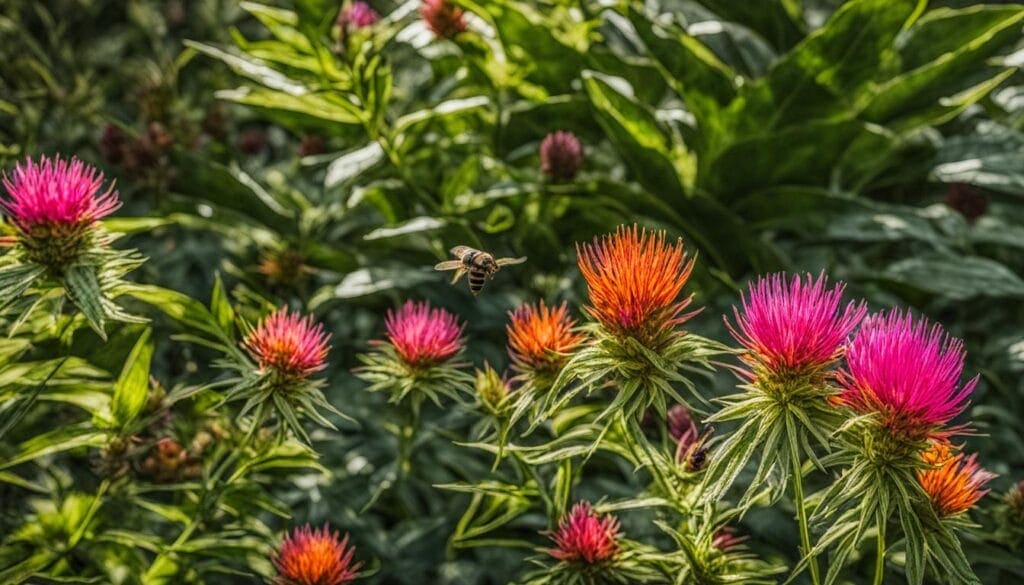
Sustainable Landscaping Practices for a Biodiverse Ecosystem
Sustainable landscaping practices are essential for creating a biodiverse ecosystem that promotes the health and vitality of both the environment and its inhabitants. By adopting ecologically friendly techniques, you can conserve water, reduce waste, and maintain healthy places for people to enjoy.
Conserving Water
Water conservation is a critical aspect of sustainable landscaping. By implementing rainwater harvesting systems, you can collect and store rainwater to be used for irrigation, reducing the need for additional water sources. This not only conserves water but also reduces the strain on municipal water supplies. Additionally, consider incorporating water-efficient irrigation methods such as drip irrigation or smart irrigation systems that adjust watering based on weather conditions. These practices help prevent water wastage and ensure that plants receive the appropriate amount of water.
Creating Healthy Soil
Healthy soil is the foundation of a successful landscape. Instead of relying on synthetic chemicals, opt for organic fertilizers and composting methods to enrich the soil. Organic fertilizers provide essential nutrients to plants while minimizing environmental harm. Composting organic waste, such as kitchen scraps and yard waste, not only reduces landfill waste but also improves soil structure and fertility. By nurturing healthy soil, you create an environment that supports the growth and well-being of native plants, contributing to the overall biodiversity of your landscape.
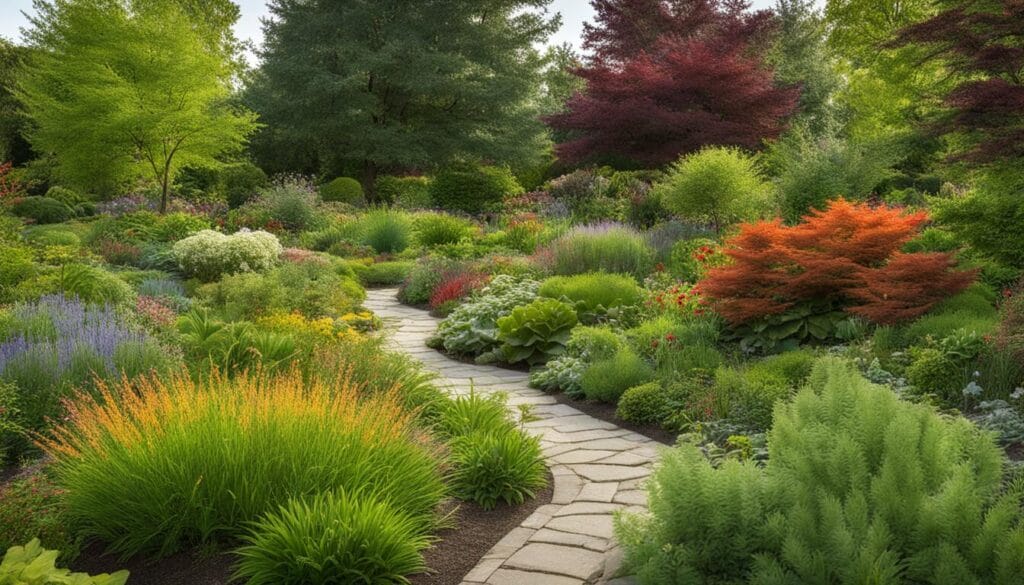
Designing with Native Plants
Choosing native plants is an integral part of sustainable landscaping. Native species are adapted to the local climate and require less maintenance, including less water and fewer pesticides. They also provide food and habitat for local wildlife, supporting the ecological balance of the ecosystem. When selecting native plants, consider factors such as soil type, sun exposure, and water requirements to ensure a successful and thriving landscape. By incorporating a variety of native plants, you create a visually appealing and biodiverse ecosystem.
| Sustainable Landscaping Practices | Benefits |
|---|---|
| Conserving water through rainwater harvesting | Reduces water usage and strain on municipal supplies |
| Using organic fertilizers and composting methods | Improves soil health and reduces environmental harm |
| Selecting native plants | Supports local wildlife and requires less maintenance |
By incorporating these sustainable landscaping practices, you contribute to the conservation of natural resources, create a resilient and biodiverse ecosystem, and promote healthy and enjoyable outdoor spaces for both people and wildlife.
Choosing Native Plants for a Vibrant Ecosystem
When it comes to creating a vibrant ecosystem in your own backyard, selecting the right native plants is crucial. Native plants are well-adapted to the local environment, making them resilient and low-maintenance. But how do you choose the best native plants for your garden? It’s important to consider factors such as soil type, sun exposure, and the specific region you’re in.
Start by researching which native plant species are native to your area. Look for resources provided by local gardening organizations or consult with experts in your community. They can provide valuable insights into the native plants that thrive in your specific region. By choosing native plants, you’ll not only support the local ecosystem but also create a visually stunning landscape.
One way to support local wildlife is by selecting native plants that provide food and habitat. For example, native flowering plants such as milkweed attract butterflies and bees, while berry-producing shrubs like viburnums provide sustenance for birds. By incorporating a variety of native plants with different colors, textures, and bloom times, you can create a diverse and beautiful habitat that supports a wide range of wildlife.
Benefits of Choosing Native Plants:
- Support local wildlife by providing food and habitat
- Require less maintenance and are well-adapted to the local environment
- Create a visually stunning landscape with a variety of colors and textures
- Promote biodiversity and contribute to the conservation of native species
“Selecting native plants that are adapted to your region is like bringing a piece of the natural landscape into your own garden. It’s a win-win situation for both you and the local wildlife.”
Remember, the key to choosing native plants is to prioritize species that are native to your specific region. By selecting the right plants and creating a biodiverse ecosystem, you can support local wildlife and contribute to the conservation of native species while enjoying a beautiful and vibrant garden.
| Common Name | Scientific Name | Sun Exposure | Soil Type | Height |
|---|---|---|---|---|
| Eastern Redbud | Cercis canadensis | Full sun to part shade | Well-drained | 20-30 feet |
| Prairie Blazing Star | Liatris pycnostachya | Full sun | Well-drained | 2-4 feet |
| Black-Eyed Susan | Rudbeckia hirta | Full sun | Well-drained | 1-3 feet |
Creating Wildlife Habitats to Support Biodiversity
Incorporating wildlife habitats into your landscape is crucial for promoting ecological balance and supporting biodiversity. By providing a welcoming environment for local wildlife, you can contribute to the preservation of natural ecosystems and create a more vibrant outdoor space. Here are some ideas and tips to help you create wildlife habitats in your own backyard:
1. Birdhouses and Feeders
Installing birdhouses and feeders is a simple yet effective way to attract a wide variety of bird species to your garden. Choose birdhouses that are suitable for different types of birds and position them strategically around your yard. Fill the feeders with bird-friendly seeds and grains to provide a consistent food source. Not only will you enjoy the presence of these beautiful creatures, but you’ll also be helping to support their populations.
2. Bee-Friendly Gardens
Bees play a vital role in pollination, making them essential for plant reproduction and the maintenance of healthy ecosystems. Create a bee-friendly garden by planting a variety of flowering plants that provide nectar and pollen. Avoid using pesticides and herbicides, as these chemicals can harm bees and other beneficial insects. By welcoming bees into your garden, you’ll be supporting their populations and contributing to the overall ecological balance.
3. Water Features
Water features such as ponds, birdbaths, or even small containers filled with water can provide a valuable water source for wildlife. Ensure that your water features have different depths to accommodate various species and place rocks or sticks in the water to provide perching or sunning spots. Adding aquatic plants to your pond can also attract frogs, dragonflies, and other fascinating creatures.
4. Native Plants for Wildlife
Choosing native plants for your landscape is not only beneficial for supporting local biodiversity but also for creating wildlife-friendly habitats. Native plants provide food and shelter for a range of wildlife, including birds, butterflies, and other insects. Research the native plants that are best suited to your region and incorporate them into your garden. Planting a diverse array of species will attract a broader range of wildlife and contribute to a thriving ecosystem.
By creating wildlife habitats in your landscape, you can promote ecological balance and support the biodiversity of your area. Remember to be patient as it may take time for wildlife to discover and utilize these habitats. With dedication and a little effort, you can transform your outdoor space into a haven for local wildlife, adding beauty and diversity to your environment.
Conclusion
Creating a biodiverse ecosystem with native plants is a rewarding endeavor that promotes conservation gardening and the preservation of native species. By implementing sustainable landscaping practices and selecting native plants, you can contribute to the protection of natural habitats and support the ecological balance of your surroundings.
By choosing native plants, you not only create a vibrant and beautiful landscape, but also provide essential food and habitat for local wildlife. Native plants are well-suited to the local environment and require less maintenance, making them an ideal choice for your garden. Promoting the growth of native species is crucial in maintaining the biodiversity of your ecosystem.
Additionally, incorporating wildlife habitats into your landscape further enhances the ecological value of your outdoor spaces. Birdhouses and feeders attract birds, while bee-friendly gardens support pollinator populations, contributing to the overall well-being of your ecosystem. Creating a welcoming environment for wildlife not only benefits the environment but also provides you with opportunities for observation and connection with nature.
So, take the first step today and start creating your own biodiverse ecosystem with native plants. By embracing conservation gardening, promoting native species, and supporting local wildlife, you will contribute to a sustainable future for both wildlife and people. Together, we can make a difference in preserving and protecting the natural world around us.
FAQ
What is Greening Australia’s commitment to restoring biodiversity?
Greening Australia aims to plant 500 million native plants and create 330,000 hectares of habitat by 2030. They are focused on establishing Koala corridors, urban biodiversity corridors, and implementing Nature-based Solutions to support biodiversity.
Why are native plants important for supporting biodiversity?
Native plants provide essential food and habitat for local wildlife, including birds and insects. They are low-maintenance, adapted to local environmental conditions, and require fewer resources like water and chemicals compared to exotic species.
What are some eco-friendly practices for sustainable landscaping?
Some eco-friendly practices include rainwater harvesting for irrigation, composting organic waste to improve soil health, and using organic fertilizers instead of synthetic ones. These practices conserve water, reduce greenhouse gas emissions, and promote plant growth without harming the environment.
Why is selecting native plants important for creating a vibrant ecosystem?
Native plants are well-suited to the local environment and require less maintenance. They support local wildlife by providing food and habitat. Choosing a variety of native plants with different colors and textures enhances the beauty of the landscape.
How can I incorporate wildlife habitats into my landscape?
You can incorporate wildlife habitats by adding birdhouses and feeders to attract birds, and creating bee-friendly gardens to promote pollinator populations. Supporting local wildlife enhances the natural balance of ecosystems and adds natural beauty to your surroundings.
Why is creating a biodiverse ecosystem with native plants important?
Creating a biodiverse ecosystem supports biodiversity and ecological balance. It contributes to the conservation of natural habitats and provides opportunities for observation and connection with nature. By embracing conservation gardening, you ensure a sustainable future for both wildlife and people.

